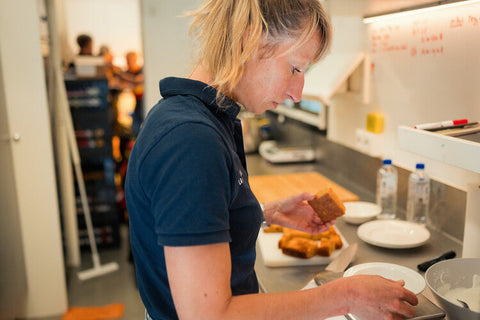It should come as no surprise that carbohydrates are the indispensable fuel during exercise. In previous blogs you have already read why you need these carbohydrates, how many you should take during exercise, what types of carbohydrates there are and with which products you can best take them. However, optimal sports performance already starts with the right preparation in the days before. A fully filled fuel tank is indispensable here. By stacking carbohydrates ('carbo loading') in the run-up to a training or competition you guarantee that your fuel tank is filled to the brim. How you do that and when you benefit from it, you can read in this blog.
In summary:
- Increasing the glycogen stores by loading carbohydrates in the run-up to an important event has been proven effective and increases performance during efforts longer than 75 to 90 minutes.
- The 'old protocol' in which people had to eat very carbohydrate-rich foods for many days in a row (and the glycogen supply had to be exhausted beforehand), has become obsolete. More recent studies show that stacking carbohydrates for 1 to 2 days is sufficient.
- During this period, take 8 to 10 grams of carbohydrates per kilogram of body weight, per day. Divide this large amount of energy preferably over 3 meals and snacks during the day. Always combine this with relative tranquility.
- Opt (partly) for easily digestible and liquid carbohydrate sources and limit the intake of protein and fat-rich products, especially if you are sensitive to stomach or intestinal complaints.
The discovery that laid the foundation for today's carbohydrate stacking
In the 1960s, a group of Scandinavian scientists showed for the first time that the intake of carbohydrate-rich products resulted in increased glycogen stores, which is the main source of fuel during exercise. They also showed that when these glycogen stores were first depleted (by not eating carbohydrates for a few days and exercising intensively) and then eating a very high-carbohydrate diet, the glycogen stores were filled even further than when a normal, high-carbohydrate diet was eaten daily. This was described as "glycogen supercompensation," which is still the basis of modern-day carbohydrate stacking (or "carbo loading"), in which one tries to increase regular glycogen stores even further in the run-up to a major event.
New Research Findings Simplify Approach for Athletes
However, the above protocol turned out to be very stressful for an athlete in practice. After all, he/she had to deplete the glycogen stores for a few days by training hard and not eating carbohydrates. This certainly does not benefit the recovery in the run-up to the important match. That is why scientists decided to investigate whether only a very carbohydrate-rich diet for a few days could achieve the same effect, without having to deplete the glycogen stores first. The results of this study confirmed that such a high carbohydrate intake for 6 to 7 days could have a similar effect, not much later new research even showed that this could be done in 1 to 2 days. Eliminating huge plates of pasta for a week or drinking many sugary drinks in the run-up to a marathon or tour, a well-known phenomenon among amateur athletes, turned out to be completely unnecessary.
The new approach to effective carbohydrate stacking
The current guideline is therefore that a carbohydrate intake of 8 to 10 grams per kilogram of body weight per 24 hours, for 1 to 2 days, is sufficient to supercompensate the glycogen stores, and thus to successfully stack carbohydrates. For someone weighing 70 kilos, that means about 560 to 700 grams of carbohydrates per day. Relative rest, so no real training load anymore, is crucial here. This ensures that your muscles will have extra fuel, which is particularly beneficial for efforts longer than 75 to 90 minutes. Think of running a (half) marathon, driving a longer tour, but also playing an important football match. To consume this large amount of carbohydrates in an easy and pleasant way, it is recommended to divide the total amount over 3 carbohydrate-rich meals and snacks. If you experience gastrointestinal problems when absorbing this large amount of energy, focus on easily digestible and liquid carbohydrate sources, such as white bread, white rice, sweet spreads and soda or fruit juice. Also limit the intake of proteins, and avoid high-fat products as much as possible.
You can find an example here:













